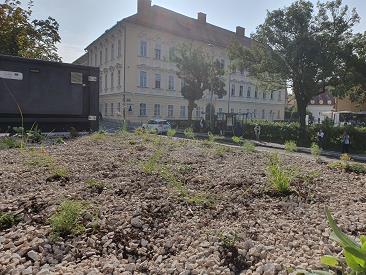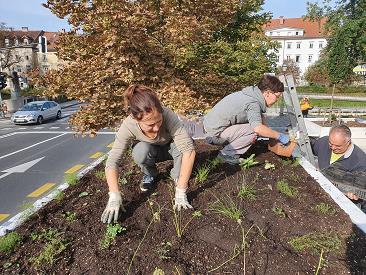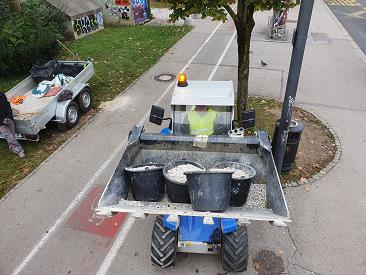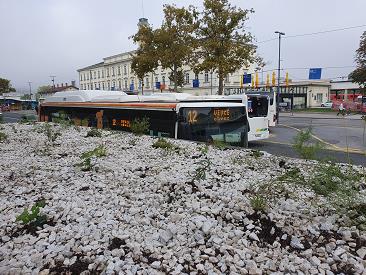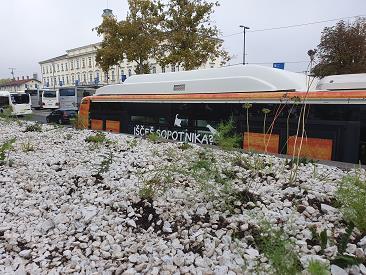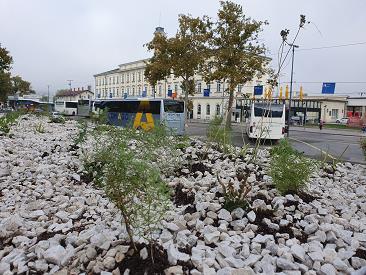On its 210th anniversary, the Botanic Garden of the University of Ljubljana started an interesting project. Together with the City of Ljubljana and company Europlakat, we began planting plants on the roofs of bus shelters of the Ljubljana public transport system. The bus shelters are made of metal and are dimensioned to withstand the considerable weight of snow, which can be quite a lot in Ljubljana over the winter. That is why we came up with the idea of planting roof gardens on bus shelters. Ljubljana continues its green policy from 2016, when it was the European Green Capital. The Botanic Garden continues to be a part of this policy, with ideas for planting and selecting tree species in the city, as well as for designing green areas. However, the planting on bus shelters was left entirely to the Botanic Garden, as a challenge. The roof with the edge is very shallow, and only allows up to seven centimetres or even less of substrate depth. The climate in Ljubljana is continental, slightly alleviated by the humidity of the Ljubljana Marshes, especially in winter. This is why summer temperatures are very high, with many sunny days, thus limiting the selection of plants suitable for bus shelters. However, because in the Botanic Garden we know the ecology of Karst species and know their natural habitats on rock shelves of Karst, we have for this purpose chosen species that can withstand the most extreme conditions. These are karst species that, in addition to their ecological adaptability, are also interesting for pollinators, especially bees. In Ljubljana, we also have the so-called Bee Path, which includes the urban apiary of the Botanic Garden of the University of Ljubljana.
We selected the three most sun-exposed bus shelters, with an area of approximately 8 m2, for planting. First, we laid a layer of felt to hold the soil, followed by a substrate mixture (sand and soil). We planted the Slovenian indigenous plant species grown from seeds in the Botanic Garden into the substrate. The plants were planted in groups similar to those found in nature, to make the surface as reminiscent of nature as possible. In order to establish conditions similar to Karst and to prevent growth of other weeds, we covered the surface with crushed stone from Karst. Due to unforeseen precipitation, one of the bus shelter gardens was watered, while the other two relied on natural precipitation. Bus shelter gardens will not be watered, as the listed species tolerate drought well – precipitation will provide their sole supply of water. However, once a year in late winter or early spring, we will cut away dry plant debris. In autumn, we will let the plants grow as long as possible to allow the green cover to grow. From the experience of planting similar roof gardens, which we have already developed at Gimnazija Ledina in Ljubljana and at the Soča University Rehabilitation Institute, it is evident that the area becomes more or less overgrown in one growing season, depending on the weather conditions. In Ljubljana, we intended to plant the bus shelter gardens at the beginning of March, but the Covid-19 epidemic prevented us from doing so. Late spring and summer are not suitable for planting, because the temperatures are too high and precipitation may be low or very infrequent, which are not the most favourable conditions for plant growth. Therefore, we postponed planting until autumn, when there is more precipitation, facilitating good growth of plants. All the bus shelters aroused much interest among the townspeople. We presented their positive responses on social networks. Several news articles were also published in various media. These tiny gardens thus created and grew a new network of green spaces in the city. Above all, they aroused great interest of the townspeople, as we planted them during the morning rush hour, when the temperatures are still bearable, resulting in a true “plant reality show” for the townspeople.
Text Jože Bavcon & Blanka Ravnjak
